#Design:
Explore tagged Tumblr posts
Photo
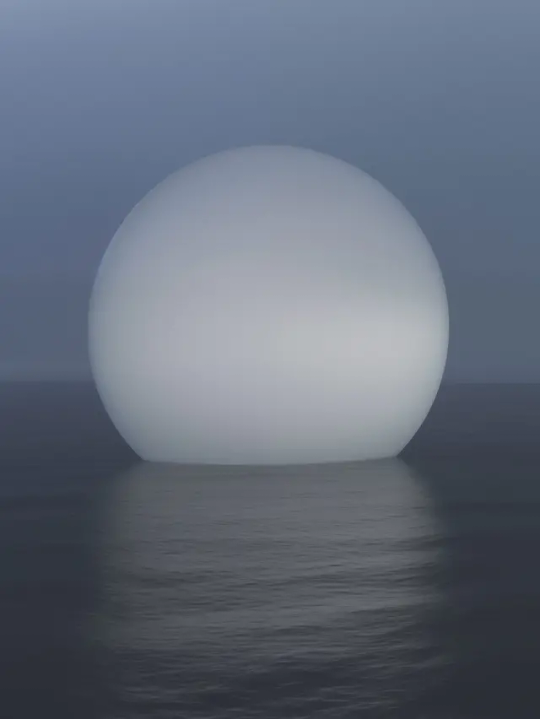
PORTO ROCHA
355 notes
·
View notes
Photo

A lil change up now, from usual critters and creatures of the world of aeon to a lil beyond to the god of everything.
39 notes
·
View notes
Photo
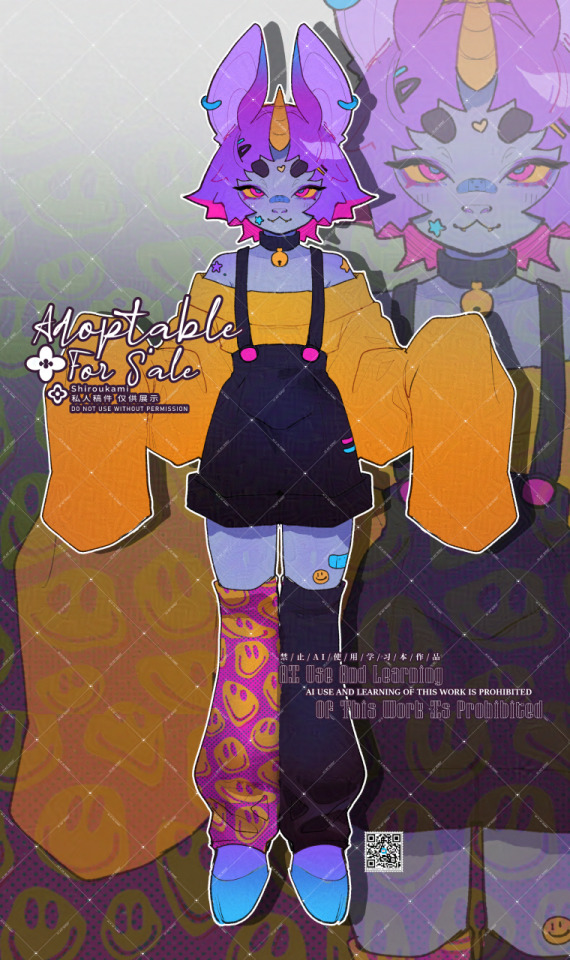
[ OTA ] Decora Gargoyle
OFFER TO ADOPT looking for $ offers for this experimental design i made! (i wanted to try designing a kemno styled furry ><) will mainly be looking for $ offers or mixed offers that include $ ──────────────────────── OFFER ON DISCORD OR TOYHOUSE ──────────────────────── Payment Plans are available if you know the specific date you will be able to pay! , please be able to at least do a 25% downpayment of the offered price. This only applies to offers over $100. ────────────────────────
Social Media | Ask me anything! | Buy me a Ko-Fi | Discord
#adoptme#adopt me#adoptablesopen#digitalart#bta#ocadopt#paytoadopt#buytoadopt#originalcharacter#artist#adoptableoc#openadopts#cute#fbseries#auction#oc#characterdesign#character#digital art#digital painting#anime#art#shiroukami#adopts#adoptables#open adopts#open adoptables#adoptable#adoptable batch#character design
4 notes
·
View notes
Text
The Importance of Investing in Soft Skills in the Age of AI
New Post has been published on https://thedigitalinsider.com/the-importance-of-investing-in-soft-skills-in-the-age-of-ai/
The Importance of Investing in Soft Skills in the Age of AI
I’ll set out my stall and let you know I am still an AI skeptic. Heck, I still wrap “AI” in quotes a lot of the time I talk about it. I am, however, skeptical of the present, rather than the future. I wouldn’t say I’m positive or even excited about where AI is going, but there’s an inevitability that in development circles, it will be further engrained in our work.
We joke in the industry that the suggestions that AI gives us are more often than not, terrible, but that will only improve in time. A good basis for that theory is how fast generative AI has improved with image and video generation. Sure, generated images still have that “shrink-wrapped” look about them, and generated images of people have extra… um… limbs, but consider how much generated AI images have improved, even in the last 12 months.
There’s also the case that VC money is seemingly exclusively being invested in AI, industry-wide. Pair that with a continuously turbulent tech recruitment situation, with endless major layoffs and even a skeptic like myself can see the writing on the wall with how our jobs as developers are going to be affected.
The biggest risk factor I can foresee is that if your sole responsibility is to write code, your job is almost certainly at risk. I don’t think this is an imminent risk in a lot of cases, but as generative AI improves its code output — just like it has for images and video — it’s only a matter of time before it becomes a redundancy risk for actual human developers.
Do I think this is right? Absolutely not. Do I think it’s time to panic? Not yet, but I do see a lot of value in evolving your skillset beyond writing code. I especially see the value in improving your soft skills.
What are soft skills?
A good way to think of soft skills is that they are life skills. Soft skills include:
communicating with others,
organizing yourself and others,
making decisions, and
adapting to difficult situations.
I believe so much in soft skills that I call them core skills and for the rest of this article, I’ll refer to them as core skills, to underline their importance.
The path to becoming a truly great developer is down to more than just coding. It comes down to how you approach everything else, like communication, giving and receiving feedback, finding a pragmatic solution, planning — and even thinking like a web developer.
I’ve been working with CSS for over 15 years at this point and a lot has changed in its capabilities. What hasn’t changed though, is the core skills — often called “soft skills” — that are required to push you to the next level. I’ve spent a large chunk of those 15 years as a consultant, helping organizations — both global corporations and small startups — write better CSS. In almost every single case, an improvement of the organization’s core skills was the overarching difference.
The main reason for this is a lot of the time, the organizations I worked with coded themselves into a corner. They’d done that because they just plowed through — Jira ticket after Jira ticket — rather than step back and question, “is our approach actually working?” By focusing on their team’s core skills, we were often — and very quickly — able to identify problem areas and come up with pragmatic solutions that were almost never development solutions. These solutions were instead:
Improving communication and collaboration between design and development teams
Reducing design “hand-off” and instead, making the web-based output the source of truth
Moving slowly and methodically to move fast
Putting a sharp focus on planning and collaboration between developers and designers, way in advance of production work being started
Changing the mindset of “plow on” to taking a step back, thoroughly evaluating the problem, and then developing a collaborative and by proxy, much simpler solution
Will improving my core skills actually help?
One thing AI cannot do — and (hopefully) never will be able to do — is be human. Core skills — especially communication skills — are very difficult for AI to recreate well because the way we communicate is uniquely human.
I’ve been doing this job a long time and something that’s certainly propelled my career is the fact I’ve always been versatile. Having a multifaceted skillset — like in my case, learning CSS and HTML to improve my design work — will only benefit you. It opens up other opportunities for you too, which is especially important with the way the tech industry currently is.
If you’re wondering how to get started on improving your core skills, I’ve got you. I produced a course called Complete CSS this year but it’s a slight rug-pull because it’s actually a core skills course that uses CSS as a context. You get to learn some iron-clad CSS skills alongside those core skills too, as a bonus. It’s definitely worth checking out if you are interested in developing your core skills, especially so if you receive a training budget from your employer.
Wrapping up
The main message I want to get across is developing your core skills is as important — if not more important — than keeping up to date with the latest CSS or JavaScript thing. It might be uncomfortable for you to do that, but trust me, being able to stand yourself out over AI is only going to be a good thing, and improving your core skills is a sure-fire way to do exactly that.
#ai#approach#Article#Articles#Artificial Intelligence#career#circles#code#coding#Collaboration#collaborative#communication#course#CSS#Design#designers#Developer#developers#development#factor#focus#Future#generative#generative ai#Giving#Global#hand#how#how to#HTML
4 notes
·
View notes
Text
50 Most Popular Types of Interior Design Styles- 02

Bridging Timelines: A Guide to Contemporary Classic Interior Design
Contemporary classic interior design is a harmonious blend of the old and the new, where timeless elegance meets modern sensibility. It's about creating spaces that feel both sophisticated and fresh, drawing inspiration from classic silhouettes and materials while incorporating contemporary elements for a dynamic and inviting atmosphere. Bridging Timelines: A Guide to Contemporary Classic Interior Design Shabby Chic Charm: Creating a Home Steeped in Nostalgia and Romance Embracing the Shadows: A Guide to Gothic Interior Design Art Nouveau: Nature's Symphony in Design Step into the Future: A Guide to High-Tech Interior Design Step into the Spotlight: A Guide to Hollywood Regency Interior Design Ahoy, Mateys! Dive into the Charm of Nautical Interior Design Saddle Up for Style: A Guide to Southwestern Interior Design Step Back in Time: A Guide to Victorian Interior Design Immerse Your Senses: A Guide to Moroccan Interior Design Finding Your Inner Peace: A Guide to Asian Zen Interior Design Groovy Grab Bag: A Deep Dive into Retro Interior Design Step into a Storybook: A Guide to Cottage Interior Design Breathe in the Mediterranean: A Guide to Tuscan Interior Design Crossing Borders, Crossing Styles: A Dive into Cultural Fusion Interior Design Skyscraper Chic: A Guide to Urban Modern Interior Design Key Characteristics of Contemporary Classic: - Neutral Color Palette with Accents: A foundation of warm or cool neutrals, like grays, beiges, or taupes, provides a timeless backdrop. Pops of color can be introduced through artwork, accent pillows, or upholstery for a touch of personality. - Clean Lines with Textural Layers: Clean lines and uncluttered surfaces define the contemporary aspect, while rich textures like velvet, linen, or wool add warmth and visual interest. - Classic Furniture with Modern Twists: Traditional furniture silhouettes, like wingback chairs or Chesterfield sofas, are reinterpreted with modern materials or updated proportions for a fresh take. - Statement Lighting: Lighting plays a crucial role in setting the mood. Opt for statement chandeliers or sculptural sconces for a touch of glamour, or sleek pendants for a more modern feel. - Artful Mix of Old and New: Don't be afraid to mix antique pieces with contemporary artwork or modern photography. This juxtaposition creates a dynamic and personalized space. Substyles of Contemporary Classic: - Mid-Century Modern: Think clean lines, pops of color, and iconic furniture pieces like Eames chairs or Noguchi coffee tables. - Scandinavian Modern: Embrace natural materials, light woods, and cozy textures for a warm and inviting take on contemporary classic. - Art Deco: Channel the glamour of the roaring twenties with geometric patterns, metallic accents, and bold statement pieces. Designing Your Contemporary Classic Space: - Start with a neutral base: Establish a foundation of neutral colors on your walls and floors to create a sense of calm and spaciousness. - Choose furniture with clean lines and timeless silhouettes: Invest in quality pieces that will last for years to come. - Layer textures and patterns: Add visual interest with throws, pillows, and rugs in a variety of textures and patterns. - Don't be afraid to mix metals: Combining different metal finishes, like gold and silver, can add depth and personality to your space. - Incorporate personal touches: Add artwork, photographs, or other meaningful objects that reflect your personality and interests. Remember: Contemporary classic is all about balance. Don't be afraid to experiment and find what works for you. The key is to create a space that feels both beautiful and comfortable, a reflection of your own unique style. Additional Tips: - Focus on quality over quantity: Invest in fewer, but better-made pieces that will stand the test of time. - Embrace natural light: Let natural light flood your space whenever possible. It will brighten your interiors and create a sense of airiness. - Accessorize thoughtfully: Don't overclutter your surfaces. Choose a few statement pieces that complement your overall design. - Don't be afraid to break the rules: Contemporary classic is a flexible style. There are no hard and fast rules, so have fun and experiment! By embracing the principles of contemporary classic interior design, you can create a home that is both stylish and timeless, a space that reflects your personal taste and offers a haven of comfort and beauty.
Shabby Chic Charm: Creating a Home Steeped in Nostalgia and Romance
Shabby chic, a design style that blends vintage charm with a touch of elegance, has captured hearts for its ability to infuse spaces with a sense of cozy nostalgia and romantic tranquility. Imagine peeling paint revealing hints of a bygone era, furniture whispering tales of generations past, and soft hues setting the stage for a relaxed and inviting atmosphere. That's the essence of shabby chic, a style that celebrates imperfection and embraces the beauty of timeworn treasures. Key Elements of Shabby Chic: - Distressed Furniture and Furnishings: The heart of shabby chic lies in furniture and furnishings that bear the marks of time. Think chipped paint, worn edges, and faded fabrics. These imperfections tell stories and add character to your space. - Soft Color Palette: A calming palette of whites, creams, and pastels dominates the shabby chic scene. These light and airy colors create a sense of spaciousness and serenity, allowing the distressed details to truly shine. - Floral Prints and Romantic Touches: Shabby chic loves florals! Whether it's on wallpaper, upholstery, or throw pillows, floral patterns add a touch of sweetness and femininity to the space. Lace, ruffles, and other romantic elements further enhance the charm. - Vintage Accents and Collectibles: Shabby chic thrives on the old and the loved. Antique finds, flea market treasures, and family heirlooms add a layer of personal history and unique character to your space. Don't be afraid to display them with pride! - Natural Light and Texture: Shabby chic spaces bask in the glow of natural light. Large windows and sheer curtains invite the sunlight in, while natural textures like wood, wicker, and linen add warmth and depth. Bringing Shabby Chic Home: Ready to infuse your own space with shabby chic charm? Here are some tips: - Start small: Don't try to overhaul your entire home at once. Begin by incorporating a few key elements, like a distressed dresser or a vintage floral rug. - Shop vintage and DIY: Flea markets, antique stores, and even your grandma's attic can be treasure troves for shabby chic finds. Don't be afraid to upcycle or refinish pieces to add your own personal touch. - Layer and mix textures: Shabby chic thrives on layers and textures. Combine soft linens with distressed wood, lace with velvet, and florals with stripes. The key is to create a sense of visual interest without feeling cluttered. - Let the light in: Maximize natural light to create a bright and airy atmosphere. Sheer curtains and light-colored walls will keep the space feeling open and inviting. - Most importantly, have fun! Shabby chic is all about creating a space that reflects your personality and makes you feel good. Don't be afraid to experiment and express yourself through your decor. Remember, shabby chic isn't about perfection; it's about celebrating the beauty of imperfection. So embrace the worn edges, the faded colors, and the quirky finds that tell a story. With a little creativity and a touch of nostalgia, you can create a home that feels both charming and comfortable, a haven where time seems to slow down and everyday moments feel imbued with a touch of magic. Beyond the Basics: While the core principles of shabby chic remain constant, there are endless ways to personalize the style. Here are a few substyles to consider: - French Country Shabby Chic: Think toile fabrics, lavender hues, and vintage French finds for a touch of rustic elegance. - Coastal Shabby Chic: Bring the beach vibes home with weathered wood, pastel blues and greens, and nautical accents. - Industrial Shabby Chic: Add an edgy touch with distressed metals, exposed brick walls, and salvaged industrial pieces. No matter your taste, there's a shabby chic variation that's sure to speak to your soul. So open your doors to the past, embrace the beauty of imperfection, and let the shabby chic charm work its magic on your home.
Embracing the Shadows: A Guide to Gothic Interior Design
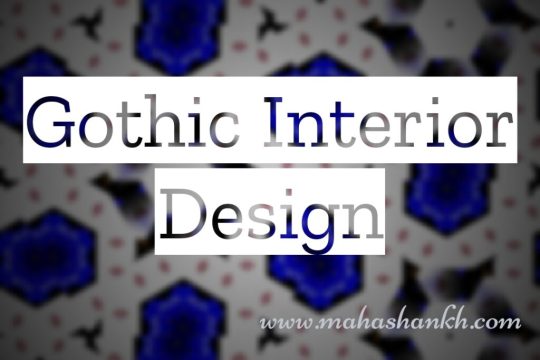
Gothic Interior Design Step into a world of dramatic contrasts, rich textures, and haunting beauty. Gothic interior design isn't for the faint of heart; it's a bold statement, a symphony of darkness and light that evokes mystery and grandeur. Dark Majesty: Foundations of Gothic Design Gothic design draws inspiration from medieval architecture and the Romantic era, weaving together elements of drama, theatricality, and a touch of the macabre. Imagine soaring ceilings punctuated by pointed arches, ornately carved furniture casting long shadows in flickering candlelight, and rich tapestries whispering tales of knights and forgotten empires. Key Elements of Gothic Interior Design: - Rich Color Palettes: Deep, jewel tones like emerald green, burgundy, and sapphire set the stage for a dramatic atmosphere. Accents of silver, gold, and bronze add a touch of luxury. - Dramatic Architectural Details: High ceilings with exposed beams, pointed arches, and stained glass windows create a sense of grandeur and mystery. Gargoyles or other sculptural elements can add a touch of the macabre. - Heavy Furniture and Fabrics: Gothic furniture features bold silhouettes and intricate carvings. Think four-poster beds, velvet armchairs, and chests decorated with ironwork. Fabrics are typically opulent, with damask, velvet, and brocade lending a sense of luxury and texture. - Moody Lighting: Candlelight and strategically placed lamps create a sense of intimacy and mystery. Chandeliers and sconces with wrought iron or crystal accents add a touch of drama. - Antiques and Curiosities: Gothic spaces love a touch of the past. Display antique weapons, vintage books, or intriguing artwork to tell a story and add a sense of timelessness. Substyles of Gothic Design: - Medieval Gothic: Think heavy oak furniture, tapestries, and stained glass windows depicting religious scenes. This style captures the essence of medieval castles and cathedrals. - Victorian Gothic: A more ornate and romantic take on Gothic, featuring dark wood furniture with intricate carvings, floral patterns, and velvet upholstery. - Modern Gothic: This contemporary interpretation incorporates sleek lines and modern materials with traditional Gothic elements like dark colors, dramatic lighting, and statement pieces. Creating Your Own Gothic Haven: Bringing a touch of Gothic charm to your home doesn't require a complete overhaul. Start small by incorporating key elements: - Paint an accent wall in a deep, dramatic color. - Add a statement piece like a four-poster bed or a velvet armchair. - Display vintage photos or artwork with a Gothic theme. - Hang tapestries or heavy curtains to create a sense of drama. - Invest in candles and strategically placed lamps for moody lighting. Remember, Gothic design is all about personal expression. Don't be afraid to mix and match styles and eras to create a space that reflects your own unique personality and sense of style. Beyond the Basics: - Play with texture: Combine smooth velvet with rough stone, or wood with metal, to create visual interest. - Don't shy away from the macabre: A touch of skulls, gargoyles, or other haunting elements can add an intriguing touch. - Balance the darkness with light: While Gothic design embraces darkness, it's important to have areas of light for balance. Natural light through stained glass windows can be particularly beautiful. - Most importantly, have fun! Gothic design is about creating a space that feels unique and inspiring to you. Embrace the mystery and drama, and let your imagination run wild. Gothic interior design is a journey into the realm of the extraordinary, a celebration of darkness and beauty in equal measure. So, open the door to your inner goth, embrace the shadows, and create a space that is both captivating and unforgettable.
Art Nouveau: Nature's Symphony in Design
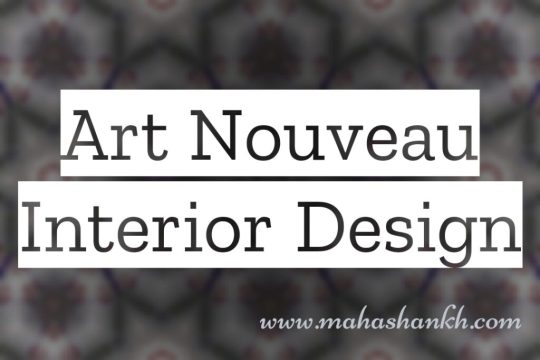
Art Nouveau: Nature's Symphony in Design Step into a realm where nature's curves intertwine with elegant forms, where light dances across shimmering surfaces, and every detail whispers a story of artistry. This is the world of Art Nouveau, a design movement that swept across Europe and America in the late 19th and early 20th centuries, leaving behind a legacy of breathtaking beauty and enduring style. Blooming from the Ashes of Tradition: Born in a time of artistic and industrial upheaval, Art Nouveau rejected the rigid formality of Victorian design and embraced the organic flow of nature. It was a rebellion against the machine, a celebration of hand-crafted artistry, and a symphony of sinuous lines, floral motifs, and vibrant colors. Key Elements of Art Nouveau Design: - Organic Lines and Forms: Gone are the straight lines and sharp corners. Art Nouveau embraces the sinuous curves of flowers, vines, and waves, weaving them into furniture, architecture, and decorative elements. - The Language of Nature: Floral motifs reign supreme, blooming across walls, furniture, and even light fixtures. Dragonflies, butterflies, and other creatures from the natural world add a touch of whimsy and movement. - Rich Materials and Textures: Glass, stained and vibrant, takes center stage, capturing and refracting light in a kaleidoscope of colors. Natural materials like wood, stone, and wrought iron add warmth and depth to the spaces. - Whimsical Touches and Artistic Expression: Art Nouveau is a canvas for imagination. Decorative elements like stained glass windows, mosaics, and sculptures become integral parts of the design, telling stories and adding unique character. - A Unified Symphony: From architecture to furniture to the smallest detail, Art Nouveau strives for a sense of cohesion. Every element flows together, creating a harmonious and immersive experience. Substyles of Art Nouveau: - French Art Nouveau: Characterized by its elegance and floral motifs, often seen in the works of Emile Gallé and Eugène Grasset. - Belgian Art Nouveau: More flamboyant and geometric, as exemplified by the bold architectural creations of Victor Horta. - British Art Nouveau: Known for its emphasis on craftsmanship and natural materials, seen in the designs of Charles Rennie Mackintosh. Bringing Art Nouveau Home: While Art Nouveau's heyday may have passed, its captivating spirit can still be incorporated into modern homes. Here are some ways to add a touch of its magic: - Embrace floral patterns: Wallpaper, upholstery, or even throw pillows can bring a touch of nature's vibrancy to your space. - Let the light flow: Stained glass panels or window hangings can add color and create a mesmerizing interplay of light and shadow. - Choose furniture with curves: Look for pieces with flowing lines and organic shapes to capture the essence of the movement. - Incorporate art and decorative elements: Sculptures, mosaics, or even vintage Art Nouveau posters can add a touch of artistic flair. - Don't be afraid to mix and match: Art Nouveau thrives on individuality. Combine elements from different substyles or eras to create a space that reflects your unique personality. Beyond the Basics: - Play with colors: Jewel tones like emerald green, sapphire blue, and deep burgundy create a dramatic yet elegant backdrop. - Incorporate natural materials: Wood, stone, and metal add warmth and texture to the space, grounding the artistic elements. - Don't forget the details: Light fixtures, door handles, and even cabinet knobs can be chosen to echo the organic forms and floral motifs of the style. - Most importantly, have fun! Art Nouveau is about celebrating life, nature, and artistic expression. Let your creativity flow and embrace the joy of creating a space that feels both beautiful and personal. Art Nouveau's legacy goes beyond aesthetics. It reminds us of the beauty and inspiration found in nature, the power of artistic expression, and the importance of creating spaces that nourish our souls. So, open your doors to the symphony of nature, let your imagination take flight, and experience the enduring magic of Art Nouveau in your own home.
Step into the Future: A Guide to High-Tech Interior Design
Read the full article
#ArtNouveau#ArtDecoInspired#ArtisticExpression#Artsandcraftsstyle#AsianFusion#AsianFusionDesign#BauhausInfluence#BohemianStyle#Bohochic#CoastalCottage#CoastalLiving#ColonialHeritage#ContemporaryRustic#CottageCore#DesertOasis#Design#EclecticDesign#FarmhouseStyle#Fashion#Frenchprovincial#FrenchCountryChic#FuturisticElements#FuturisticInteriors#Globalnomad#GothicGlam#High-TechModern#HighTechLiving#HollywoodRegency#Indian#IndustrialChic
8 notes
·
View notes
Video
youtube
A short video explaining how easy it is to customise one of my creations at Cheerful Madness!! at Spreadshirt.
You can find this particular t-shirt here
You can see the whole shop here Cheerful Madness!! at Spreadshirt
#cheerfulmadness#kawaii#tshirts#spreadshirt#cartoon#cute#cute animals#cheerful madness#designer#video#youtube video
2 notes
·
View notes
Text

My attempt on Monkie Kid OC (and drawing a modern hanfu.... failed at the modern part)
But yeah, she goes by Qīqī. I she is a snake demon, though some sources call her kind fairies or spirits... I’m still going with demon.
And yes. She is based on Qīng shé/Xiǎoqīng/Green Snake. Am I going to design her sister? Probably not. At least, not for a long time.
#lmk#monkie kid#lego monkie kid#lmk oc#I struggled with her colours#because Mei is already pretty much a green snake#so I considered making her blue because technically her name allows that#well in theory her hair and pants are dark teal :p#I will probably play with her design a lot soo this is by no means final#I also need to learn how to draw folds on fabric#among many other things#my drawings
2 notes
·
View notes
Video
youtube
Resident Evil 2 (2019) – Game World Ambience – Greenhouse
Deep within the Umbrella NEST facility and the rainforest like Greenhouse that houses the now overgrown and out of control Plant 43, one of the many experimental bioweapons developed in the NEST
For other game world ambience videos check out this playlist https://www.youtube.com/playlist?list=PLFJOZYl1h1CFo5LyAEvdIcP4syymQaI50
youtube
#youtube#ambience#game world ambience#horror#survival horror#resident evil#short#shorts#gaming shorts#gaming video#sound design#leon kennedy#resident evil 2#resident evil 2 remake#nest#bioweapon#biohazard#greenhouse#plant 43#gaming#video games#background noise
0 notes
Link
Rebranding failures can can have catastrophic effects. So why (and how) does it happen to some very high profile brands? Let’s explore…
#Branding#Brand Strategy#Brand Identity#Advertising#Marketing Graphic Design#Packaging Design#Logo Design#Freelance Graphic Designer#Graphic Designer#Design Agency
0 notes
Photo
⊙ INNER TERRITORY ⊙

大森とストーリー 07 Oomori , Tokyo Konica C35FD FUJI 業務用100 大森とストーリーシリーズ
87 notes
·
View notes
Photo
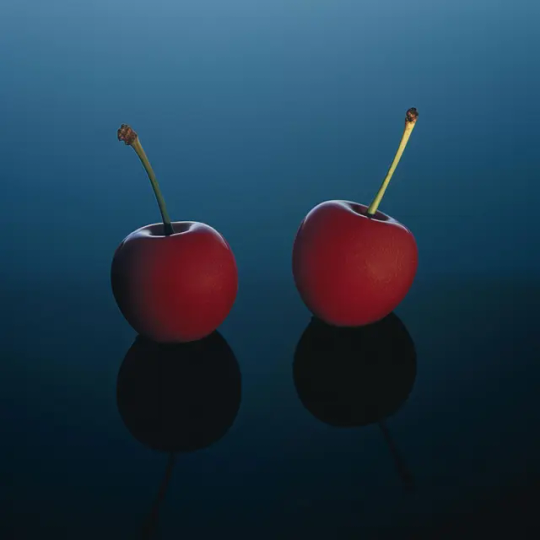
PORTO ROCHA
48 notes
·
View notes
Photo

[ OTA ] FB #034
OFFER TO ADOPT ──────────────────────── STATUS/OFFER ON DISCORD OR TOYHOUSE ──────────────────────── PAYPAL USD ONLY Payment Plans are available if you know the specific date you will be able to pay! , please be able to at least do a 25% downpayment of the SB price. This only applies if the bid goes over $100. ────────────────────────
Social Media | Ask me anything! | Buy me a Ko-Fi | Discord
#adoptme#adopt me#adoptablesopen#digitalart#bta#ocadopt#paytoadopt#buytoadopt#originalcharacter#artist#adoptableoc#openadopts#cute#fbseries#auction#oc#characterdesign#character#digital art#digital painting#anime#art#shiroukami#adopts#adoptables#open adopts#open adoptables#adoptable#adoptable batch#character design
0 notes
Text
Revisiting CSS Multi-Column Layout
New Post has been published on https://thedigitalinsider.com/revisiting-css-multi-column-layout/
Revisiting CSS Multi-Column Layout
Honestly, it’s difficult for me to come to terms with, but almost 20 years have passed since I wrote my first book, Transcending CSS. In it, I explained how and why to use what was the then-emerging Multi-Column Layout module.
Hint: I published an updated version, Transcending CSS Revisited, which is free to read online.
Perhaps because, before the web, I’d worked in print, I was over-excited at the prospect of dividing content into columns without needing extra markup purely there for presentation. I’ve used Multi-Column Layout regularly ever since. Yet, CSS Columns remains one of the most underused CSS layout tools. I wonder why that is?
Holes in the specification
For a long time, there were, and still are, plenty of holes in Multi-Column Layout. As Rachel Andrew — now a specification editor — noted in her article five years ago:
“The column boxes created when you use one of the column properties can’t be targeted. You can’t address them with JavaScript, nor can you style an individual box to give it a background colour or adjust the padding and margins. All of the column boxes will be the same size. The only thing you can do is add a rule between columns.”
She’s right. And that’s still true. You can’t style columns, for example, by alternating background colours using some sort of :nth-column() pseudo-class selector. You can add a column-rule between columns using border-style values like dashed, dotted, and solid, and who can forget those evergreen groove and ridge styles? But you can’t apply border-image values to a column-rule, which seems odd as they were introduced at roughly the same time. The Multi-Column Layout is imperfect, and there’s plenty I wish it could do in the future, but that doesn’t explain why most people ignore what it can do today.
Patchy browser implementation for a long time
Legacy browsers simply ignored the column properties they couldn’t process. But, when Multi-Column Layout was first launched, most designers and developers had yet to accept that websites needn’t look the same in every browser.
Early on, support for Multi-Column Layout was patchy. However, browsers caught up over time, and although there are still discrepancies — especially in controlling content breaks — Multi-Column Layout has now been implemented widely. Yet, for some reason, many designers and developers I speak to feel that CSS Columns remain broken. Yes, there’s plenty that browser makers should do to improve their implementations, but that shouldn’t prevent people from using the solid parts today.
Readability and usability with scrolling
Maybe the main reason designers and developers haven’t embraced Multi-Column Layout as they have CSS Grid and Flexbox isn’t in the specification or its implementation but in its usability. Rachel pointed this out in her article:
“One reason we don’t see multicol used much on the web is that it would be very easy to end up with a reading experience which made the reader scroll in the block dimension. That would mean scrolling up and down vertically for those of us using English or another vertical writing mode. This is not a good reading experience!”
That’s true. No one would enjoy repeatedly scrolling up and down to read a long passage of content set in columns. She went on:
“Neither of these things is ideal, and using multicol on the web is something we need to think about very carefully in terms of the amount of content we might be aiming to flow into our columns.”
But, let’s face it, thinking very carefully is what designers and developers should always be doing.
Sure, if you’re dumb enough to dump a large amount of content into columns without thinking about its design, you’ll end up serving readers a poor experience. But why would you do that when headlines, images, and quotes can span columns and reset the column flow, instantly improving readability? Add to that container queries and newer unit values for text sizing, and there really isn’t a reason to avoid using Multi-Column Layout any longer.
A brief refresher on properties and values
Let’s run through a refresher. There are two ways to flow content into multiple columns; first, by defining the number of columns you need using the column-count property:
Second, and often best, is specifying the column width, leaving a browser to decide how many columns will fit along the inline axis. For example, I’m using column-width to specify that my columns are over 18rem. A browser creates as many 18rem columns as possible to fit and then shares any remaining space between them.
Then, there is the gutter (or column-gap) between columns, which you can specify using any length unit. I prefer using rem units to maintain the gutters’ relationship to the text size, but if your gutters need to be 1em, you can leave this out, as that’s a browser’s default gap.
The final column property is that divider (or column-rule) to the gutters, which adds visual separation between columns. Again, you can set a thickness and use border-style values like dashed, dotted, and solid.
These examples will be seen whenever you encounter a Multi-Column Layout tutorial, including CSS-Tricks’ own Almanac. The Multi-Column Layout syntax is one of the simplest in the suite of CSS layout tools, which is another reason why there are few reasons not to use it.
Multi-Column Layout is even more relevant today
When I wrote Transcending CSS and first explained the emerging Multi-Column Layout, there were no rem or viewport units, no :has() or other advanced selectors, no container queries, and no routine use of media queries because responsive design hadn’t been invented.
We didn’t have calc() or clamp() for adjusting text sizes, and there was no CSS Grid or Flexible Box Layout for precise control over a layout. Now we do, and all these properties help to make Multi-Column Layout even more relevant today.
Now, you can use rem or viewport units combined with calc() and clamp() to adapt the text size inside CSS Columns. You can use :has() to specify when columns are created, depending on the type of content they contain. Or you might use container queries to implement several columns only when a container is large enough to display them. Of course, you can also combine a Multi-Column Layout with CSS Grid or Flexible Box Layout for even more imaginative layout designs.
Using Multi-Column Layout today
Patty Meltt is an up-and-coming country music sensation. She’s not real, but the challenges of designing and developing websites like hers are.
My challenge was to implement a flexible article layout without media queries which adapts not only to screen size but also whether or not a <figure> is present. To improve the readability of running text in what would potentially be too-long lines, it should be set in columns to narrow the measure. And, as a final touch, the text size should adapt to the width of the container, not the viewport.
Article with no <figure> element. What would potentially be too-long lines of text are set in columns to improve readability by narrowing the measure.
Article containing a <figure> element. No column text is needed for this narrower measure.
The HTML for this layout is rudimentary. One <section>, one <main>, and one <figure> (or not:)
<section> <main> <h1>About Patty</h1> <p>…</p> </main> <figure> <img> </figure> </section>
I started by adding Multi-Column Layout styles to the <main> element using the column-width property to set the width of each column to 40ch (characters). The max-width and automatic inline margins reduce the content width and center it in the viewport:
main margin-inline: auto; max-width: 100ch; column-width: 40ch; column-gap: 3rem; column-rule: .5px solid #98838F;
Next, I applied a flexible box layout to the <section> only if it :has() a direct descendant which is a <figure>:
section:has(> figure) display: flex; flex-wrap: wrap; gap: 0 3rem;
This next min-width: min(100%, 30rem) — applied to both the <main> and <figure> — is a combination of the min-width property and the min() CSS function. The min() function allows you to specify two or more values, and a browser will choose the smallest value from them. This is incredibly useful for responsive layouts where you want to control the size of an element based on different conditions:
section:has(> figure) main flex: 1; margin-inline: 0; min-width: min(100%, 30rem); section:has(> figure) figure flex: 4; min-width: min(100%, 30rem);
What’s efficient about this implementation is that Multi-Column Layout styles are applied throughout, with no need for media queries to switch them on or off.
Adjusting text size in relation to column width helps improve readability. This has only recently become easy to implement with the introduction of container queries, their associated values including cqi, cqw, cqmin, and cqmax. And the clamp() function. Fortunately, you don’t have to work out these text sizes manually as ClearLeft’s Utopia will do the job for you.
My headlines and paragraph sizes are clamped to their minimum and maximum rem sizes and between them text is fluid depending on their container’s inline size:
h1 font-size: clamp(5.6526rem, 5.4068rem + 1.2288cqi, 6.3592rem); h2 font-size: clamp(1.9994rem, 1.9125rem + 0.4347cqi, 2.2493rem); p font-size: clamp(1rem, 0.9565rem + 0.2174cqi, 1.125rem);
So, to specify the <main> as the container on which those text sizes are based, I applied a container query for its inline size:
main container-type: inline-size;
Open the final result in a desktop browser, when you’re in front of one. It’s a flexible article layout without media queries which adapts to screen size and the presence of a <figure>. Multi-Column Layout sets text in columns to narrow the measure and the text size adapts to the width of its container, not the viewport.
Modern CSS is solving many prior problems
Structure content with spanning elements which will restart the flow of columns and prevent people from scrolling long distances.
Prevent figures from dividing their images and captions between columns.
Almost every article I’ve ever read about Multi-Column Layout focuses on its flaws, especially usability. CSS-Tricks’ own Geoff Graham even mentioned the scrolling up and down issue when he asked, “When Do You Use CSS Columns?”
“But an entire long-form article split into columns? I love it in newspapers but am hesitant to scroll down a webpage to read one column, only to scroll back up to do it again.”
Fortunately, the column-span property — which enables headlines, images, and quotes to span columns, resets the column flow, and instantly improves readability — now has solid support in browsers:
h1, h2, blockquote column-span: all;
But the solution to the scrolling up and down issue isn’t purely technical. It also requires content design. This means that content creators and designers must think carefully about the frequency and type of spanning elements, dividing a Multi-Column Layout into shallower sections, reducing the need to scroll and improving someone’s reading experience.
Another prior problem was preventing headlines from becoming detached from their content and figures, dividing their images and captions between columns. Thankfully, the break-after property now also has widespread support, so orphaned images and captions are now a thing of the past:
figure break-after: column;
Open this final example in a desktop browser:
You should take a fresh look at Multi-Column Layout
Multi-Column Layout isn’t a shiny new tool. In fact, it remains one of the most underused layout tools in CSS. It’s had, and still has, plenty of problems, but they haven’t reduced its usefulness or its ability to add an extra level of refinement to a product or website’s design. Whether you haven’t used Multi-Column Layout in a while or maybe have never tried it, now’s the time to take a fresh look at Multi-Column Layout.
#:has#ADD#almanac#Article#Articles#back up#background#book#box#browser#challenge#clamp#colours#columns#container#content#course#creators#CSS#CSS Grid#css-tricks#Design#designers#desktop#developers#digitalocean#display#easy#English#Explained
2 notes
·
View notes
Text
Quelle Montre Homme Tendance choisir en 2024
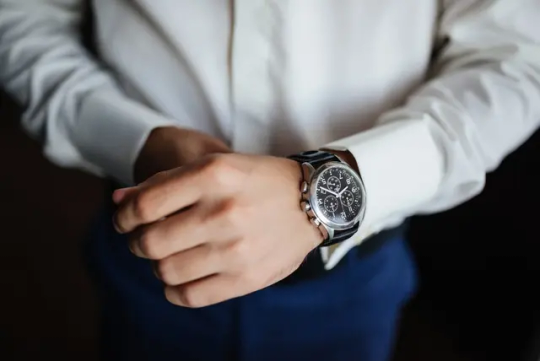
À la quête d'un présent singulier et éternel pour marquer une occasion spéciale ? Plongez dans l'univers fascinant de montre homme tendance et découvrez des garde-temps dont le succès est indéniable, offrant une combinaison parfaite de style, de précision et de durabilité. Laissez-vous guider par notre expertise chez Guide-Cadeaux, où nous vous dévoilerons non seulement des conseils éclairés pour votre sélection, mais aussi une collection de montres qui ont déjà conquis le cœur des amateurs. Faites de votre cadeau une expérience inoubliable en choisissant une montre qui transcende le temps avec élégance et raffinement. Introduction Quel type de montre choisir : mécanique, manuel ou à quartz ? Choisir le cadran d'une montre homme tendance Choisir le bracelet pour la montre que vous offriez Acheter une montre homme tendance de luxe Points à retenir avant d'acheter une montre tendance La montre idéale pour un jeune homme ou un homme de 30 ans (environ) Quelle montre pour un homme de 50 ans ou 60 ans ? Conclusion :
Introduction
Choisir la montre parfaite peut s'avérer être un défi, d'autant plus lorsqu'il s'agit de décider entre les différentes technologies disponibles sur le marché. Lorsque l'on se penche sur les mécanismes de montres, trois options principales se dégagent : mécanique, manuel et à quartz. Parmi celles-ci, les montres mécaniques se distinguent par leur charme et leur esthétique inégalée.
Quel type de montre choisir : mécanique, manuel ou à quartz ?
Les montres mécaniques, alimentées par un mouvement complexe et élaboré, incarnent l'essence même de l'horlogerie traditionnelle. Leur mécanisme, alimenté par le mouvement naturel du poignet, témoigne de l'artisanat minutieux et de la précision technique. Opter pour une montre mécanique, c'est choisir une pièce d'exception, une symbiose parfaite entre tradition et modernité. Au-delà de leur fonctionnalité, les montres mécaniques se démarquent par leur look inimitable. Chaque pièce est une œuvre d'art, alliant des matériaux de qualité supérieure à un design raffiné. Que vous recherchiez une allure classique, vintage ou contemporaine, les montres mécaniques offrent des choix sans équivoques pour tous les styles. En investissant dans une montre mécanique, vous acquérez bien plus qu'un simple accessoire. Vous faites l'acquisition d'une pièce maîtresse qui transcende le temps, un compagnon fidèle dont l'élégance et la sophistication ne se démodent jamais. Optez pour l'excellence horlogère avec une montre mécanique, une fusion parfaite entre la fonctionnalité impeccable et l'esthétique incomparable. Guide-cadeaux.com Cliquez sur la photo pour agrandir
Sélection de cadeaux
Fossil Montre pour Homme Nate
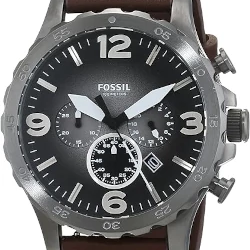
Prix & descriptif Guide-cadeaux.com Cliquez sur la photo pour agrandir
Sélection de cadeaux
Fossil Montre Coachman
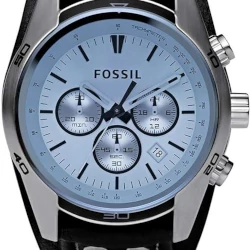
Prix & descriptif Guide-cadeaux.com Cliquez sur la photo pour agrandir
Sélection de cadeaux
Fossil Quartz chronographe

Prix & descriptif
Choisir le cadran d'une montre homme tendance
Lorsque vous envisagez de choisir le cadran d'une montre homme tendance, plusieurs éléments entrent en ligne de compte, façonnant l'esthétique globale de votre accessoire. Le choix entre un cadran rond, rectangulaire ou carré revêt une importance particulière, déterminant le style et la personnalité de la montre. Le cadran rond demeure le choix classique et répandu par excellence. Sa forme intemporelle s'adapte à une variété de styles, du décontracté à l'élégant, en faisant une option polyvalente qui traverse les tendances.
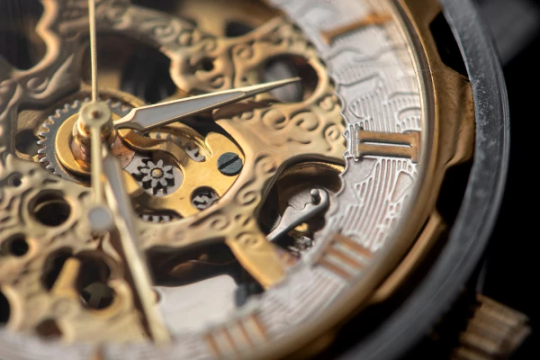
En ce qui concerne la couleur du cadran, l'option entre le noir et le bleu est souvent influencée par le degré de classicisme recherché. Le noir offre une sobriété indémodable, conférant à la montre une élégance discrète et adaptable à toutes les occasions. D'autre part, le bleu apporte une touche de modernité tout en conservant une certaine élégance. Opter pour le classicisme, qu'il s'agisse d'un cadran rond noir ou bleu, les chiffres romains, constitue une décision judicieuse. C'est un choix sûr qui survivra aux tendances éphémères, assurant à votre montre une allure intemporelle et une capacité à s'adapter à toutes les occasions. En fin de compte, le cadran de votre montre homme tendance devrait refléter votre style personnel tout en évoquant une sophistication qui traverse les époques. Considérez d'abord l'âge de la personne, car cela influence les préférences esthétiques. Les cadrans ronds, rectangulaires ou carrés peuvent être associés à différents groupes d'âge. Ensuite, explorez le style de vie et le goût vestimentaire de la personne. Un cadran classique convient à une personne élégante, tandis qu'un cadran moderne ou urbain apporte une touche d’originalité contemporaine. L'harmonie entre l'âge, le style urbain, moderne, classique ou mode garantit que la montre sera à la fois personnelle et à la pointe de la mode.
Choisir le bracelet pour la montre que vous offriez
Une question importante qui influence le style d'une montre homme tendance concerne le choix du bracelet, une décision qui doit être soigneusement adaptée à la personne qui recevra ce cadeau. Parmi les options les plus prisées, les bracelets en cuir et en métal se distinguent, apportant chacun leur propre élégance et raffinement. Les bracelets en cuir évoquent une sophistication, parfaitement adaptée aux amateurs de styles classiques et aux individus d'âge mûr. D'autre part, les bracelets en métal confèrent une allure moderne et urbaine, idéale pour ceux qui préfèrent un style plus actuel et contemporain. Cependant, il est recommandé d'éviter les bracelets en plastique, car ils ne véhiculent pas une image de qualité, en particulier auprès des seniors ou de ceux au style classique. Le choix du bracelet devient ainsi un élément essentiel pour personnaliser la montre, assurant qu'elle s'alignera parfaitement avec le goût, le style de vie et l'esthétique de celui qui la portera. En fin de compte, le bracelet contribue à définir l'identité de la montre adapté à la personnalité de son destinataire.
Acheter une montre homme tendance de luxe
Les montres de marques prestigieuses telles que Rolex, Patek Philippe, Audemars Piguet, Omega et Jaeger-LeCoultre sont souvent considérées comme des choix emblématiques dans le monde de l'horlogerie de luxe. Ces marques renommées sont réputées pour leur excellence technique, leurs matériaux de haute qualité et leur esthétique exceptionnelle. Ces marques renommées sont réputées pour leur excellence technique, leurs matériaux de haute qualité et leur esthétique exceptionnelle mais sont également prisées pour un investissement.
Points à retenir avant d'acheter une montre tendance
- le style de la personne: urbain, mode ou sportif - la grosseur du boitier : si celui-ci est trop gros, cela peut entraîner une gène en certaines occasions - la technologie : automatique, quartz, manuel selon la préférence de chacun - la marque : gage de qualité et de longévité - la lisibilité du cadran (surtout plus les personnes plus âgées) Guide-cadeaux.com Cliquez sur la photo pour agrandir
Sélection de cadeaux
LOUIS XVI Palais Royale 893
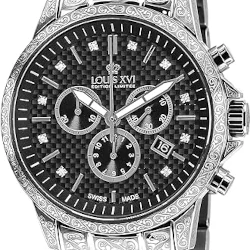
Prix & descriptif Guide-cadeaux.com Cliquez sur la photo pour agrandir
Sélection de cadeaux
chronographe Emporio Armani
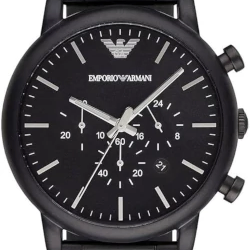
Prix & descriptif Guide-cadeaux.com Cliquez sur la photo pour agrandir
Sélection de cadeaux
Seiko analogique quartz
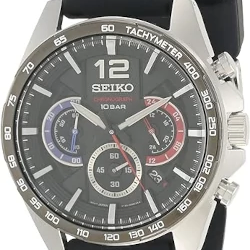
Prix & descriptif
La montre idéale pour un jeune homme ou un homme de 30 ans (environ)
Lorsque l'on s'adresse à une clientèle plus jeune, un jeune homme ou un jeune adulte, l'aspect de l'originalité prend une place significative dans le choix d'une montre. Cependant, il est bon de trouver l'équilibre subtil entre l'expression individuelle et la maturité que la montre doit refléter. Les marques horlogères contemporaines proposent une gamme diversifiée de designs novateurs, offrant des options qui allient style audacieux et sophistication. Un jeune homme peut être attiré par une montre tendance avec un cadran original, une complication créative et un bracelet unique. Les montres intégrant des éléments modernes tels que des matériaux innovants, des couleurs vives et des détails avant-gardistes peuvent être particulièrement attractives. Toutefois, même dans la recherche de l'originalité, il est essentiel de prendre en considération la personnalité et le style de vie du jeune homme qui portera la montre. La praticité et la durabilité restent des critères importants, même dans le domaine de la créativité horlogère. Guide-cadeaux.com Cliquez sur la photo pour agrandir
Sélection de cadeaux
Zeppelin Uhr 100 Jahre
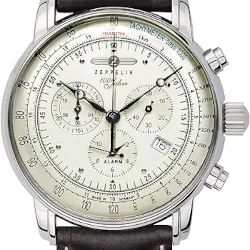
Prix & descriptif Guide-cadeaux.com Cliquez sur la photo pour agrandir
Sélection de cadeaux
BENYAR Homme Etanche
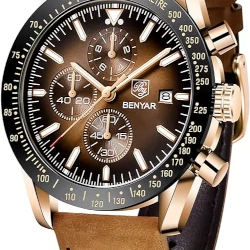
Prix & descriptif Guide-cadeaux.com Cliquez sur la photo pour agrandir
Sélection de cadeaux
Mido automatique
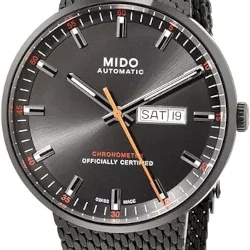
Prix & descriptif
Quelle montre pour un homme de 50 ans ou 60 ans ?
Le choix d'une montre pour ces hommes de 50 et plus doit être orienté vers des styles plus classiques et intemporels. Les montres automatiques ou mécaniques sont souvent appréciées pour leur sophistication et leur artisanat exceptionnel. Les modèles avec des cadrans simples, mais élégants, dans des tons neutres comme le noir ou le gris, peuvent être privilégiés. Un point qu'il convient de vérifier est la lisibilité du cadran en toutes conditions, certains trop petits ou avec des reflets peuvent difficiles à lire ou avec des reflets Les montres avec des bracelets en cuir de qualité ou en acier inoxydable offrent une touche de raffinement adaptée à cet âge. Les diamètres de boîtiers plus larges, mais pas exagérés, peuvent être préférés pour mieux s'adapter à la morphologie masculine. La marque et la réputation de la maison horlogère peuvent également jouer un rôle important dans le choix. Des maisons renommées pour leur artisanat et leur histoire dans l'horlogerie sont recherchées pour leur qualité et leur durabilité.
Conclusion :
Chaque homme a son propre style et ses préférences uniques, il convient donc de s’adapter à chacun. Certains peuvent préférer des montres plus contemporaines ou des designs spécifiques en fonction de leurs goûts personnels, de leur profession ou de leur style de vie. L'essentiel est de choisir une montre qui reflète la personnalité et les goûts de l'homme concerné, tout en offrant une touche d'élégance intemporelle. Vous aimerez aussi : vélo électrique pliant, perceuse visseuse, drone Read the full article
0 notes
Text
100 Empowering Designs: Elevate Your Space with Positivity and Strength in the world

The Importance of Design Shaping Our World, One Decision at a Time Design is all around us, from the clothes we wear to the way our cities are laid out. It shapes our experiences and influences our emotions. But what exactly is design? And what makes it so important? What is Design? In its simplest form, design is the act of creating something. But it's much more than just that. Design is about intentionality. It's about using our creativity and problem-solving skills to create things that are not only functional but also beautiful and meaningful. Good design takes into account the needs of the user. It considers how people will interact with a product or space and how it can make their lives better. It also considers the impact of design on the environment and society as a whole. The Different Disciplines of Design There are many different disciplines of design, each with its own focus and set of skills. Some of the most common disciplines include: - Graphic design: The art of creating visual communication, such as logos, posters, and websites. - Product design: The design of physical objects, such as furniture, cars, and toys. - Fashion design: The design of clothing and accessories. - Interior design: The design of the interior spaces of buildings. - Landscape design: The design of outdoor spaces, such as gardens and parks. - UX/UI design: The design of user interfaces and experiences for digital products. Why is Design Important? Design is important for many reasons. It can: - Make our lives easier and more efficient. A well-designed product is easy to use and understand, which can save us time and frustration. - Make our lives more enjoyable. A beautifully designed space or object can bring us joy and inspiration. - Help us to connect with others. Design can create a sense of community and belonging. - Make the world a better place. Sustainable design can help to reduce our impact on the environment. - Boost your brand identity. A well-designed logo, website, and packaging can make your brand instantly recognizable and memorable. - Increase sales and conversions. Good design can make your products and services more appealing to customers, which can lead to increased sales and conversions. Embracing Sustainability in Design: A Comprehensive Overview of Sustainable Design Practices The Art and Craft of Costume Design: Weaving Narratives through Fabric and Form The Art and Science of Set Design: A Comprehensive Exploration Advancements in 3D Modeling and Animation A Comprehensive Exploration of Virtual Reality (VR) Design: Shaping Immersive Experiences Augmented Reality (AR) Design: Bridging the Virtual and Physical Realms The Art and Science of Sound Design in Media Production The Art and Science of Social Media Design: Crafting an Impactful Digital Presence The Art and Science of Mobile App Design: Crafting Seamless User Experiences Understanding the Essence of Responsive Design in Modern Web Development The Art and Science of Print Design Exploring the Essence of Illustration Design The intersection of photography and design Crafting Immersive Experiences: The Art and Science of Game Level Design Unveiling the Art and Science of Instructional Design FQAs based on types of design The Future of Design The future of design is full of possibilities. As technology continues to evolve, we can expect to see even more innovative and creative designs. We can also expect to see design play an even more important role in addressing the challenges facing our world, such as climate change and inequality. Design is a powerful tool that can shape our world for the better. By understanding the principles of design and appreciating its importance, we can all be part of creating a more beautiful, functional, and sustainable future.
Embracing Sustainability in Design: A Comprehensive Overview of Sustainable Design Practices

Embracing Sustainability in Design: A Comprehensive Overview of Sustainable Design Practices Sustainable design has evolved from a niche concept to a central pillar in contemporary design practices. This article explores the principles, benefits, and key considerations associated with sustainable design, shedding light on how designers can contribute to a more environmentally conscious and socially responsible future. Defining Sustainable Design: Sustainable design, also known as eco-design or green design, involves creating products, buildings, and systems with a focus on minimizing environmental impact while optimizing functionality and aesthetics. It encompasses a holistic approach that considers environmental, social, and economic aspects throughout the entire design process. Principles of Sustainable Design: - Resource Efficiency: Sustainable design emphasizes the responsible use of resources by promoting energy efficiency, reducing waste, and utilizing renewable materials. Designers strive to create products that have a minimal ecological footprint. - Life Cycle Assessment (LCA): Conducting a life cycle assessment is integral to sustainable design. This involves evaluating the environmental impact of a product or system from raw material extraction to disposal. LCA helps designers make informed decisions that reduce overall environmental harm. - Biophilic Design: Integrating natural elements into design not only enhances aesthetics but also promotes well-being. Biophilic design incorporates features such as natural lighting, green spaces, and sustainable materials, fostering a connection between users and the environment. - Adaptability and Flexibility: Sustainable design anticipates change and seeks to create adaptable solutions. This involves designing products and spaces that can evolve with user needs, reducing the likelihood of premature obsolescence. Benefits of Sustainable Design: - Environmental Conservation: Sustainable design contributes to the conservation of natural resources, mitigating environmental degradation. By prioritizing renewable energy sources and minimizing waste, designers play a crucial role in the fight against climate change. - Cost Savings: While initial costs may be higher for sustainable design projects, the long-term benefits often outweigh the expenses. Energy-efficient buildings, for example, result in lower operational costs over their lifespan. - Enhanced User Well-being: Incorporating biophilic elements and sustainable practices enhances the quality of spaces and products, positively impacting the health and well-being of users. Natural light, improved air quality, and ergonomic designs contribute to a healthier living and working environment. - Market Differentiation: In an era where consumers are increasingly environmentally conscious, sustainable design provides a competitive edge. Brands that prioritize sustainability demonstrate corporate responsibility, attracting a growing market of eco-aware consumers. Challenges and Considerations: - Balancing Priorities: Designers often face the challenge of balancing environmental considerations with functional and aesthetic requirements. Achieving harmony between these aspects requires thoughtful decision-making and innovative solutions. - Material Selection: The choice of materials significantly influences a design's sustainability. Designers must navigate the complexities of material sourcing, considering factors such as durability, recyclability, and embodied energy. - Global Standards and Certification: Adhering to recognized sustainability standards and certifications, such as LEED (Leadership in Energy and Environmental Design), can be a complex process. Designers must stay informed about evolving standards and regulations to ensure compliance. Sustainable design is not just a trend; it is a responsibility. As designers, architects, and creators, embracing sustainable practices is essential for crafting a better future. By integrating eco-friendly principles into the design process, professionals can contribute to a more resilient, resource-efficient, and socially conscious global community. As the demand for sustainable solutions continues to grow, the role of sustainable design in shaping our world becomes increasingly pivotal.
The Art and Craft of Costume Design: Weaving Narratives through Fabric and Form

The Art and Craft of Costume Design: Weaving Narratives through Fabric and Form Costume design is an intricate and indispensable facet of the entertainment industry that goes beyond aesthetics, involving meticulous planning, creativity, and an in-depth understanding of the characters and narratives. This article delves into the world of costume design, exploring its significance, process, and the impactful role it plays in bringing stories to life on stage and screen. The Significance of Costume Design: Costume design is not merely about dressing characters; it is a visual language that communicates aspects of the character's personality, era, social status, and even emotional state. The costumes contribute significantly to the overall ambiance and atmosphere of a production, enhancing the audience's immersion into the world being portrayed. Read full article visit on https://mahashankh.com/100-types-designs-positivity-strength/ Read the full article
#Design#GraphicDesign#WebDesign#UIUX#Creative#Art#DigitalDesign#VisualCommunication#Typography#LogoDesign#BrandIdentity#Illustration#UserExperience#UserInterface#ProductDesign#PrintDesign#ColorTheory#LayoutDesign#ResponsiveDesign#DesignInspiration#DesignThinking#ConceptDesign#FlatDesign#Minimalism#ModernDesign#AbstractArt#Branding#DesignersLife#DigitalArt#VisualDesign
1 note
·
View note